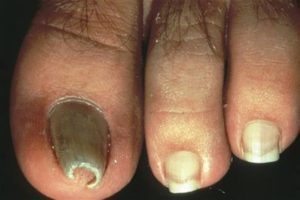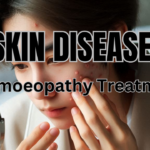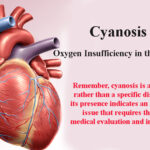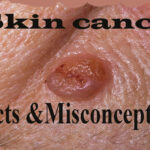Fingernails can provide clues to your overall health. Healthy nails are usually smooth, consistent in colour and free of spots or discoloration.


Nail is a horn-like envelope made up of keratinized protein, covering the dorsal aspect of the terminal phalanges of fingers and toes. It consists of the nail plate; the nail matrix and the nail bed below it; and the grooves surrounding it. Its chief function is to protect the distal phalanx, the fingertip, and the surrounding soft tissues from injuries. It also helps to enhance precise delicate movements of the fingers.
For humans, nails mature at an average rate of 3 mm (0.12 in) per month. Fingernails need 3 to 6 months to regrow entirely, whereas toenails needs 12 to 18 months. Real growth rate depends on age, exercise level, season, regime, masculinity and genetic factors. Nails grow quicker in summer than other seasons. Healthy nails are usually smooth, consistent in colour and free of spots or discoloration. Nail glitches that sometimes need management includes bacterial and fungal infections, malformed nails, tumors and lumps. Other than these some systemic diseases are also accompanied by nail problems like-Psoriasis, Diabetes, Rheumatoid Arthritis etc. Sometimes it is the other way round when certain nail changes suggest underlying diseases in the form of:
Beau’s lines or grooves
These are 1 mm wide depression in the nail plate that extends horizontally from one lateral nail groove to the other. Commonly develop following dramatic illness such as cardiovascular complaints and periods of high fever or malnutrition. Other causes of transverse ridges include psoriasis, paronychia and eczema.
Clubbing of nails(Drumstick fingers, Hippocratic fingers)
Increased convexity of nail fold, seen with chronic pulmonary or cardiopulmonary disease but also occurs with some tumors, especially those of the lung parenchyma
Longitudinal ridging
Causes include lichen planus, rheumatoid arthritis and peripheral arterial disease.
Pitted nails
Causes include alopecia areata (patchy hair loss), psoriasis and eczema.
White Banding of Nails
Horizontal white banding or opacification, seen in hypoalbuminemia accompanying chronic hepatic or renal disease
Brown banding of nails
Horizontal or vertical brown opacity or strips
Upright – subordinate to nevus or malignance Horizontal – Addison’s disease, cancer chemotherapy
Koilonychia
Spoon shaped nails, which occur due to Iron deficiency
Common Nail Complaints

Ingrowing toenail
- A common problem resulting from various causes – eg, improperly trimmed nails, trauma, poorly fitting shoes, abnormally shaped nails or pressure from other digits.
- It often presents with pain but may progress to infection and difficulty with walking.
- Treatment options include cutting nails square, hot water soaks, cotton wool inserts at the nail edges, antibiotics or excision and wedge excision or total excision of nail. A Cochrane review found that surgical treatments were more effective than non-surgical treatments.
Onycholysis
- The nail becomes detached from its bed at the base and side, creating a space under the nail that accumulates dirt. Air under the nail may cause a grey-white color but can vary from yellow to brown.
- In psoriasis there may be a yellowish-brown margin between the margin between the normal nail (pink) and the detached parts (white).
Psoriasis
- Virtually all patients with psoriasis have nail involvement at some time and it occurs in 50% of cases at any given time.
- Abnormalities include nail pits, transverse furrows, crumbling nail plate, and roughened nails.
Paronychia
Paronychia (also known as whitlow) describes localized inflammation of the tissue around a nail. There may be formation of pus stuck between skin and nail matrix. The area may become swollen, red and tender. If it lasts longer than six weeks, it is termed chronic paronychia.
Brittle Nails
These are characterized by a vertical splitting or separation of the nail plate layers at the distal (free) edge of the nail plate. In most cases, nail splitting and vertical edges are character of the normal aging course. This nail problem is also because of overexposure to water and chemical thinners such as household washing solutions.
Tips to keep Nails Healthy
Most of the above troubles can easily be dealt with or prevented if we pay a little attention to our nails. This would keep them healthy, shiny and disease free; some of the common tips include :
- Don’t abuse your nails. To prevent nail damage, don’t use your fingernails as tools to pick, poke or pry things.
- Don’t bite your nails or pick at your cuticles. These habits can damage the nail bed. Even a minor cut alongside your nail can allow bacteria or fungi to enter and cause an infection (paronychia).
- Keep your nails dry and clean. This prevents bacteria, fungi or other organisms from growing under the nail. Clean under the nails regularly and thoroughly dry your hands and feet after bathing. Wear rubber gloves when using soap and water for prolonged periods.
- Keep your nails short, square shaped and slightly rounded on top. Trim brittle nails after a bath or a 15-minute hand soak in bath oil. Then apply a moisturizer.
- Trim nails and file nails regularly. Trim nails straight across and file down thickened areas. Trimming and filing are easier and safer if done just after bathing or soaking the nails.
- Never pull off hangnails – doing so almost always results in ripping living tissue. Instead clip off hangnails, leaving a slight angle outward.
- Wear shoes that fit properly. Shoes that place excessive pressure on your toes or pinch your toes may cause your nails to grow into surrounding tissue.
- Moisturize your nails frequently. Nails need moisture just like your skin does. Rub lotion into your nails when moisturizing your hands. Be sure to apply a moisturizer after removing fingernail polish.
- Watch for problems. If you have a nail problem that doesn’t seem to go away on its own or is associated with other signs and symptoms, make an appointment with your doctor to get it checked out.
Homeopathic Remedies
Some Homeopathic remedies which help in nailing the Nail troubles include:
- Antim crud:Good for Brittle nails
- Graphitis:For brittle nails with deformity & cracks in skin.
- Fluoric acid:For nails which crumble
- Psorinum:Nail problems with psoriasis.
- Silicea: Ingrowing toe-nails, white spot on nails.
Other medicines: Sabadilla, Magnetis Polus Australis, Nitric acid, Causticum are some other remedies which also have good role in nail complaints.
NB– These medicines have to be consumed as per the advice of a qualified homeopathy doctor.
Dr. Tejasvi K.P
Reader- Dept. of Surgery
Bhagwan Buddha Homeo Medical college
Mallathalli, Bangalore
Consultant- Surabhi Homeo clinic, BEL layout, Vidyaranyapura, Bengaluru -97
Mob:97311 33819
Email:drtejas2000@rediffmail.com












